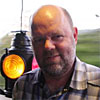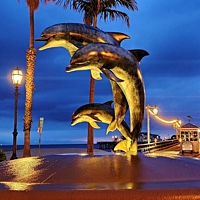Home » Jazz Articles » Live Review » International Jazz Day: Istanbul, Turkey April 30, 2013
International Jazz Day: Istanbul, Turkey April 30, 2013
Istanbul, Turkey
April 30, 2013
At a morning press conference opening the 10th annual Panama Jazz Festival in January, 2013, a long table was peopled by dignitaries and musical dignitaries. Festival highlight, saxophonist Wayne Shorter sat in the center (almost like Jesus in the Last Supper configuration), flanked by the ambitious and outspokenly idealistic festival founder, pianist Danilo Pérez, singer Ruben Blades, and Shorter's longtime friend and ally, pianist Herbie Hancock. At some point, late in the proceedings that morning, Hancock made a declaration: "I was just thinking that on April 30th , it will be the official International Jazz Day in Istanbul, and this is the official preface, the first step, for International Jazz Day."
It may have been an impromptu concept, or a preplanned statement, but clearly, the rendezvous in Istanbul was on Hancock's mind. In his capacity as the UNESCO Goodwill Ambassador for Intercultural Dialogue and present Chairman of the Thelonious Monk Institute—both organizations involved in the now two-year-old International Jazz Day—not to mention a musician whose passion for education and becoming an ever-greater cross-cultural communicator for the jazz cause—Hancock has been deeply invested in what the International Jazz Day is and represents.
As the Panama festival and various discussions proceeded, it also became apparent that Panama City and Istanbul have much in common, as vital cultural junction points in the world, literally and symbolically connecting east and west, north and south. These global hot spots are often seen as harbingers of peace and cultural understanding. Ditto, the connective and peaceable force of jazz, for musicians and listeners, across borders.
This novel, noble venture began in 2012, with simultaneous events— all on April 30—in Paris, France, at the UN in New York City, and in jazz's birthplace in New Orleans, LA, in the epicenter of Congo Square. 2013's model, centered in Istanbul, also spread its wings and influence across the world, with simultaneous concerts and events in locales gone global—and viral. A day of panels, conferences, musical moments and other jazz-centric doings around the city culminated in a two-hour grand gala concert at the ancient Hagia Eirene Museum (a vast mosque-like structure dating back further than the famed Hagia Sophia).
That gala evening came musically fortified with an all-star cast of musicians—an international cast—including Hancock, Shorter, guitarist John McLaughlin, bassist/vocalist Esperanza Spalding, trumpeter Terence Blanchard, Blades, singers Al Jarreau and Dianne Reeves, tablaist Zakir Hussain, Brazilian singer/songwriter Milton Nascimento, trumpeter/vocalist Hugh Masakela, violinist Jean-Luc Ponty, saxophonist Branford Marsalis... the list went proverbially on and on.
Fast forwarding from Panama City early this year to April in Istanbul, from one idealistic, global-minded jazz event to another, and it was another bright and early (by jazz standards) morning gathering in Istanbul on April 30. The day's program began in the Galatasary High School, the city's oldest high school, with a history going back to the 15th century. If it was Tuesday, this had to be International Jazz Day, commencing with speechifying and music-making.
UNESCO director-general Irina Bokova's offered her lavish praise and a UNESCO Medal to Shorter, who later gamely sat in with the gifted twenty-something current class of the Thelonious Monk Institute (now based at UCLA), to the evergreen tune of the saxophonist's classic "Footprints," duly stretched into fresh territory on that stage. (The gifted current Monk Institute class: trumpeter Mike Cottone, alto saxophonist Joshua J. Johnson, trombonist Erich Miller, vibraphonist Diego Urbano, bassist David Robaire and drummer Jonathan Pinson).
The musical component of the morning also included a brief history of jazz—led by singer Lisa Henry, our "jazz tour guide"—for the benefit of the auditorium full of high school students. A brief, genre and period-hopping history of jazz classics was performed, from the Ellingtonia of "Take the A Train" through saxophonist Charlie Parker's "Donna Lee," Miles Davis/Gil Evans' "Boplicity," saxophonist Ornette Coleman's "Lonely Woman" and Antonio Carlos Jobim's "The Girl from Ipanema" to tunes by in- house icons, Shorter's "One by One" and Hancock's comfy funk standard, "Chameleon." From the next generation of jazz players came Monk Institute student trumpeter Cottone's cool original, "E Force."
In his speech that morning, Hancock toasted the worldly crossroads capital that is Istanbul, saying, "your city exemplifies the beauties of jazz." Bringing his attention more to the room at hand, he said, "when I see students' eyes light up, then I know why I do what I do. The future caretakers of jazz are here with us."
By day, on International Jazz Day, a series of events wove its way across venues around the city, nearby the Taksim area and the day's home base, the Marti Istanbul Hotel. One could walk down the long pedestrian boulevard of the Istiklal Caddesi—also the address of the Galatasary—and swing by various events, stopping for tea, roasted chestnuts or Turkish Delight candies along the way.
Down at the Beyoglu Municipality Youth Center, a panel discussion called "Jazz Festivals: The work and art of promoting jazz around the world" brought together some prominent European festival directors and significant figures, including the Umbria Festival's Carlo Pagnotti, the Vienne festival's Fritz Thom, Jean-Rene Palacio (Jazz a Juan and the Monte Carlo Jazz Festival), and Claire Whitaker, whose director of the company Serious, is partly responsible for the London Jazz Festival.
Clearly, for decades, the jazz festival circuit and scene across the Atlantic has had a critical role in nurturing, preserving and nudging jazz culture forward, and in a stronger way than some of its counterparts in America. Asked by a member of the audience about the process and considerations involved in choosing a festival program, Palacio stated, simply, "It's for you. We must sell tickets, but we all have a passion for jazz." He pointed to the money-oriented choice of booking Sting, which allows him to then showcase emerging and more genuinely jazz-inclined talent, adding that, "keeping the soul of the music alive is very important."
At the end of the panel, Whitaker wisely commented—in a statement which registers deep in the institutional ethos of jazz supporters and International Jazz Day at its core—that, compared to other more commercial areas of music, "jazz is not the easy choice, but you get a quality of engagement."
There was plenty of quality engagement going down—and turning multiple corners—that night at the Hagia Eirene. UNESCO head Bokova set the sweeping stage for the event by telling the capacity, invitation-only crowd that, "tonight, Istanbul is the capitol of jazz." Hancock introduced the evening by noting the global network of related activities and energies, touching every country in the world and every state in the U.S. He asserted, "I can't imagine something that promotes peace and fosters goodwill as jazz does... it's a symbol of possibilities."
In an intentionally wide-ranging and eclectic musical pageant, smartly and elaborately organized by the inherently flexible Los Angeles-based keyboardist John Beasley, the stylistic map began with the root system of the blues, via "Some Kind of Wonderful," sung with soulful gusto by Joss Stone and Joe Louis Walker. Latin jazz met swing era nostalgia as Ruben Blades sang "Begin the Beguine," beguine-style, with funk, Braziliana (Nascimento's lustrous "Traversia," with old comrade Shorter weaving sinuous lines on soprano sax) and shades of bop (be-, hard, and neo-) filtered through the night. So did a touch of Indian-flavored jazz, courtesy of McLaughlin, Hussain and Ponty, while South African musical heat and righteous social indignation came from Masakela.
This being jazz—subject to change and muse-kissed chops on given themes—improvisational high points of the show sometimes materialized on the fly. Some kind of magic swarmed into the air as Esperanza Spalding and pianist Robert Glasper traded riffs on "Afro Blue," and formidable Russian tenor saxophonist Igor Butman fell into a deep dialogue with Terence Blanchard on "Isfahan," while clarinetist Anat Cohen, the increasingly high profile Israeli-in-New York, proved what the fuss about her is all about.
Turkish elements in the program, in the real-time present tense, included impressive Turkish players, trumpeter Imer Demirer and dazzling guitarist Bilal Karaman, and notably spotlight-seizing clarinetist Hüsnü Şenlendirici. Repertoire-wise, the set list navigated through Arabic-related standards, including "Isfahan," "Night in Tunisia" and "Caravan," as well as Al Jarreau's take on recently departed pianist Dave Brubeck's "Blue Rondo à la Turk," inspired by a rhythm Brubeck heard while on the streets in Istanbul.
Significant sons of great American legends were involved in the program, as well. Drummer T.S. Monk was on hand, with a microphone and some inspired words to convey to the crowd, starting with a ripe ecumenical blessing in this 500-year-old Orthodox church: "I would like to thank all the holy spirits who are allowing this evening to happen." Soon after, Martin Luther King III spoke, recalling his father's speech given at the 1964 Berlin Jazz Festival, a speech with the telling title Jazz Speaks for Life."
Capping off a whirlwind musical world tour under one ancient roof in Istanbul, in a show well-documented for broadcast, streaming and otherwise disseminating into the known world, International Jazz Day circled its way to a take on "Night in Tunisia" with all the musicians onstage and in the spirit. Dianne Reeves crystallized the universal- minded but also site-specific feeling of the moment in one of her trademarked "you are here" scatting riffs: "Under a bright Turkish moon/the world is celebrating International Jazz Day."
In phase two of this massive and yet definitively concentrated undertaking, by all accounts a resoundingly successful venture in its 2013 model, the deeper implied message remains the same: while the focus is on what happens on one day, April 30, the grander message has to do with making jazz a 24/7/365 entity in the pantheon of world cultures.
< Previous
Odean's Three
Next >
Conrairo
Comments
Tags
Herbie Hancock
Live Reviews
Josef Woodard
United States
California
Santa Barbara
Wayne Shorter
Danilo Perez
Thelonious Monk
john mclaughlin
Esperanza Spalding
Terence Blanchard
Al Jarreau
Dianne Reeves
Zakir Hussain
Milton Nascimento
Hugh Masakela
Jean-Luc Ponty
Branford Marsalis
Mike Cottone
Josh Johnson
Eric Miller
Diego Urbano
Dave Robaire
Jonathan Pinson
Lisa Henry
Charlie Parker
Miles Davis
Gil Evans
Ornette Coleman
Antonio Carlos Jobim
Sting
John Beasley
Robert Glasper
Igor Butman
Anat Cohen
Dave Brubeck
T.S. Monk
Concerts
Sep
13
Fri
For the Love of Jazz
 All About Jazz has been a pillar of jazz since 1995, championing it as an art form and, more importantly, supporting the musicians who create it. Our enduring commitment has made "AAJ" one of the most culturally important websites of its kind, read by hundreds of thousands of fans, musicians and industry figures every month.
All About Jazz has been a pillar of jazz since 1995, championing it as an art form and, more importantly, supporting the musicians who create it. Our enduring commitment has made "AAJ" one of the most culturally important websites of its kind, read by hundreds of thousands of fans, musicians and industry figures every month.
























